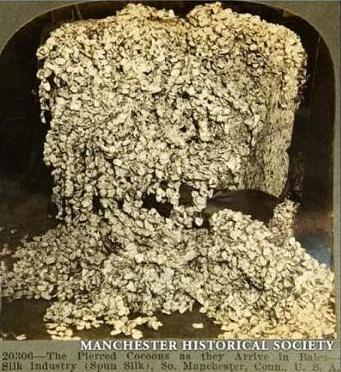



So. Manchester, Conn., U.S.A.
Not all silk threads are made from raw silk, however. There is another class made from waste silk by spinning, and known as spun silk threads. Waste silk is obtained from several sources. Many moths are permitted to hatch and escape from the cocoon so that a new supply of eggs may be obtained. These pierced cocoons supply much of the waste silk. In reeling, waste silk is obtained from the outside fibre of the cocoon, and from the inside next to the chrysalis. Other waste silk is produced in the various processes of manufacture. To the above sources of waste silk may be added double cocoons and cocoons stained by the premature death of the chrysalides. This spun silk is not as beautiful, strong, and brilliant as the product of reeled silk manufacture.
Imports of waste silk into the United States in 1912 amounted to nearly 5,000,000 pounds, valued at $2,500,000.
The pierced cocoons are imported in bales of about four hundred pounds. The bales are opened and the contents carefully examined in order to remove as much dirt and foreign matter as possible. The cocoons are next boiled for a number of hours with a quantity of soap and are then washed. This is to remove the gum which holds the fibres together. They are then dried and are ready for the next of manufacture, known as dressing.

 )
)